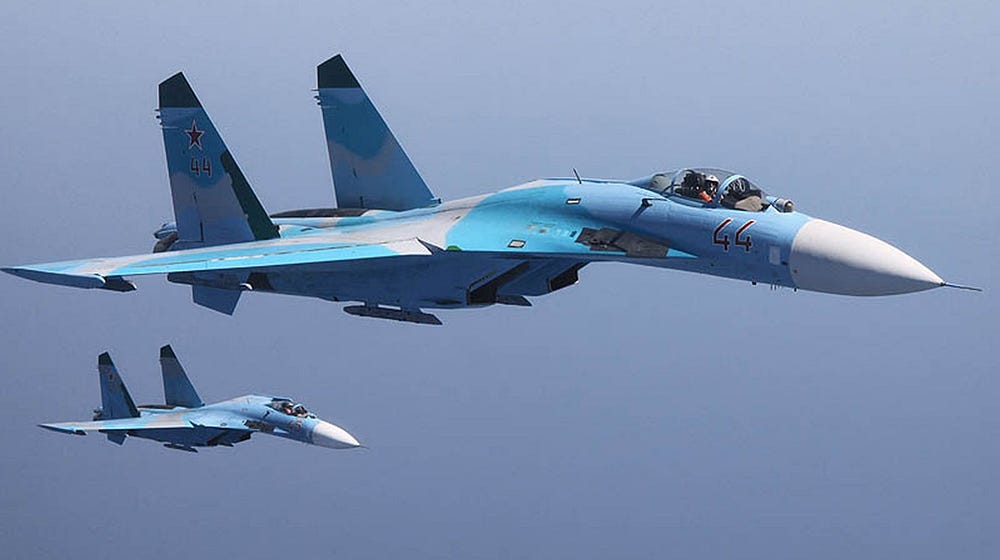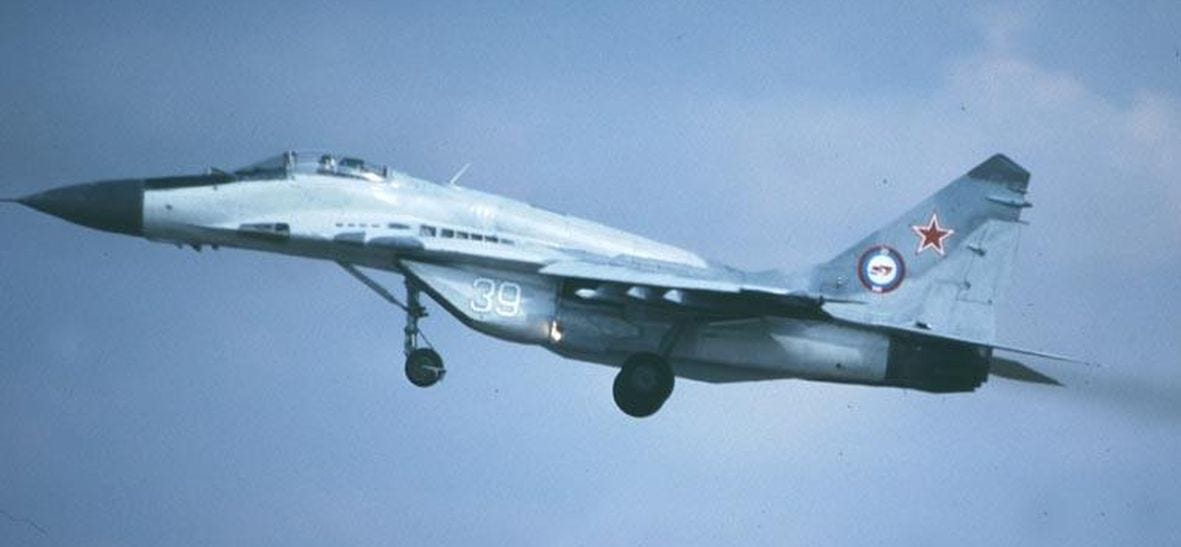
Posted on 09/05/2016 4:48:42 AM PDT by sukhoi-30mki

Compromised and de-facto obsolete as soon as it entered service — an Su-27SM of the Russian air force. NATO release
In March 1986, U.S. Navy aviators out-flew, out-maneuvered and jammed the Libyan Arab Air Force so badly that the Libyans stopped flying their interceptors over the Gulf of Sidra.
As a result, Tripoli had to give up its claim on this part of the Mediterranean. Equally damaging, the lack of air cover allowed the Americans to attack with relative impunity.
You could chalk up the Americans’ success to superior training and tactics. But don’t dismiss another potentially important factor — espionage. By the mid-1980s, the U.S. military had obtained reams of vital intelligence on Soviet-made weaponry, particularly aircraft and related systems, from Adolf Georgievich Tolkachev, a disgruntled Soviet engineer.
Tolkachev was, arguably, the man who wrecked the Soviet warplane industry.
Consider the Americans’ sound defeat of Libyan forces.
On March 24, 1986 — having already cleared the air space over the Gulf of Sidra — U.S. Navy planes easily knocked out a Libyan SA-5 Gammon surface-to-air missile site at Sirte and then sank several fast missile craft of the Libyan navy.
Only a month later, U.S. Air Force F-111Fs bombed three carefully-selected targets in Tripoli, while Navy A-6E Intruders struck two targets in Benghazi.
Despite fierce resistance from Libyan air defenses, the Americans lost only one of their fighter-bombers.
Adding insult to injury, in January 1989 a pair of U.S. Navy F-14A Tomcats shot down two Libyan air force MiG-23MF interceptors.
The U.S. winning streak continued through the 1990s.
In 1991, U.S. air power overwhelmed the Iraqi air force in a matter of three days. After flying just a few defensive missions, the Iraqi air force— a well-equipped air arm shaped and seasoned by eight years of bitter war with Iran — was all but grounded and subsequently evacuated its most precious aircraft to Iran.
Except in a handful of cases, Iraq’s elaborate ground-based air defenses — patiently developed at great cost over nearly 20 years — proved no major hindrance to U.S. forces.
These are only four out of about a dozen examples in which U.S. air power overwhelmed its opponents in the last 30 years. Now, one could argue that the opponents in question were no match for the Americans — that they were poorly trained, poorly commanded, inexperienced and equipped with downgraded export models of Soviet-made aircraft and armament.
That they were, in other words, a far cry from the kind of threat the Soviets, and later Russians, themselves represented. Well-informed Iraqi and Libyan sources counter this impression, insisting that their air forces possessed modern equipment operated by well-trained and skilled officers and pilots.
Some might go as far as to say that the Serbian air force and ground-based air defenses fared much better when confronting U.S.-led NATO air power in 1995 and 1999. Others would stress that, by the late 1990s, Iraqi air defenses were so worn out, and so constrained by nonsensical orders from top political leaders, that they posed greater danger to themselves than to their opponents.
However, leaving aside details about aircraft and equipment, training, tactics, strategy, politics and other background noise, one thing remains common in all these operations — U.S. forces’ amazing level of knowledge about the Soviet and Russian weapons systems used by the Libyans, Iraqis and Serbs.
For example, the pilots of the U.S. Navy A-7E Corsair IIs that attacked the Libyan SA-5 Gammon SAM site near Sidra during the evening of March 24, 1986, knew the exact performance specs of the system they were facing.
Likewise, the crews of the two F-14A Tomcats that shot down a pair of Libyan MiG-23MFs had intricate knowledge of the swing-swing MiG-23. U.S. Air Force F-15 pilots hunting MiGs over Iraq in the period 1991 to 2002 knew precisely what their opponents’ aircraft, avionics and armament were capable of doing.

The MiG-29 was severely hit by the Tolkachev affair, and Soviets reacted by fielding the MiG-29SMT, depicted here. However, such efforts were far from satisfactory, while a lack of funding caused delays lasting decades. Tom Cooper Collection photo
Evidence indicates that superior intelligence was the key to American military successes. Consider that the tactical manuals that the U.S. Air Force’s Fighter Weapons School issued in the late 1980s were already well-informed about even the latest Soviet equipment, including the MiG-29, Su-27, SA-10 Grumble, SA-11 Gadlfy and many others.
Tolkachev provided much of the most useful intelligence. He was, in the 1970s and ’80s, an electronics engineer at the Soviet Union’s Scientific Research Institute of Radar, better known as the Phazotron Design Bureau — the USSR’s main developer of military radars and avionics.
Motivated by the persecution of his wife’s parents under Joseph Stalin and disappointed in the communist government, Tolkachev established ties to the U.S. Central Intelligence Agency in Moscow and, beginning in 1979, began transferring huge volumes of highly classified and extremely sensitive data about the most important avionics, radars and weapons installed in Soviet-made combat aircraft.
The amount of material that “Donald,” as Tolkachev was known to the CIA, was such that U.S. translators couldn’t keep up with it. They remained busy translating and studying the information Tolkachev had provided well into the 1990s.
As early as December 1979, the U.S. Defense Department completely reconfigured the electronics package for one of its latest fighter aircraft, based on the information from Tolkachev.
An internal CIA evaluation from March 1980 praised Tolkachev’s information on the latest generation of Soviet surface-to-air missile systems. “We never before obtained such detail and understanding of such systems until years after they were actually deployed,” the CIA stressed.
In April 1980, another internal CIA memorandum called Tolkachev’s information on jam-proofing tests for Soviet fighter aircraft radar systems “unique.” Obviously, Tolkachev provided data that no other CIA asset had access to.
Only few months later, Tolkachev was credited with “providing unique information on a new Soviet fighter aircraft, and documents on several new models of airborne missile systems.”
Similarly, a memorandum from the Defense Department from September 1980 praised the impact of Tolkachev’s reporting as “limitless in terms of enhancing U.S. military systems’ effectiveness.” Tolkachev’s leaks had the “potential to save lives and equipment” and were “instrumental in shaping the course of billions of dollars of U.S. research and development activities.”
The extent of the damage Tolkachev caused the Soviets is hard to summarize in a few sentences. What little the CIA did release about its cooperation with Tolkachev indicates that he might have inflicted irreparable harm to the Soviet military aviation and air-defense industries.
He certainly provided the Americans with full insight into modern Soviet-made aircraft such as as the MiG-29, MiG-31 and Su-27 and their air-to-air missiles — and enabled U.S. scientists and engineers to quickly develop electronic countermeasures against these systems.
Perhaps more importantly, the Tolkachev affair hit the Soviet Union at a time of instability for the USSR. A Soviet spy in the United States revealed Tolkachev’s own spying in early 1985. The Soviet government executed Tolkachev in 1986.
However, the Soviet Union by then was bankrupting itself — and dissolved in 1991. For most of the 1990s, what was left of the Russian military aviation and air-defense industries languished due to a general lack of funding. Major upgrades of the newest combat aircraft and various air-defense systems — all urgently necessary because of Tolkachev’s treachery — took decades to implement.
In the words of one Sukhoi engineer, “it took more than 10,000 different upgrades and over 20 years” merely to improve the original Su-27 to the Su-27SM-standard, and thus “repair some of the damage” Tolkachev caused.
While full details on what exactly Tolkachev revealed to the CIA are unlikely to become public for a number of years, it was certainly a lot. The effects of his treachery — foremost the fact that an entire generation of brand-new combat aircraft, air-to-air and even surface-to-air missiles was compromised and thus became obsolete as soon as it entered service — are still being felt in Russia today.
Eisenhower et. al. were sweating bullets over the weather forecast, and if they had known that the Germans had an additional division of forces in Normandy they would have probably delayed - and possibly ultimately abandoned - D-Day. And if the Germans had had Hillary-scale leakage of classified information coming to them - rather than quite the reverse - they would’ve had enough additional divisions in Normandy to make an attempted opposed landing there utterly unthinkable. Quite simply, “too hard."
Thanks for the ping. Tolkachev was an anti-communist hero. I wonder if we caught the Soviet spy in the United States who revealed him.
If it was in the 1980s it was likely Ames that gave him up.
We had another alternative that was successful. It would have split Hitler’s forces in France.
https://en.wikipedia.org/wiki/Operation_Dragoon
Or Jimmy Carter. I would not put it past either of them.
Thanks. Yes, it could have been Ames.
“Hopefully we don’t rely on the hubris of the past instead of the reality of today...”
Do you mean that we cannot just sit on our asses for 2 generations and expect the rest of the world to do the same?
You do realize that there’s a HUGE BUNCH of Cold Warriors on this site ready to follow Obama and Hillary into World War 3 against Russia. They WILL NOT appreciate your comment.
Mr. Cooper is full of it here. Much of the Iraqi Air Force was sitting on the tarmac at Riyadh International Airport during the Iran-Iraq war, How can your air forces be 'shaped and seasoned', when its materiel assets are sitting in the 'custody' of a third party?
How do I know this to be a fact? Simple, in 1981 I was working at Riyadh International, and had some of those same Iraqi Air Force planes, with Iraqi Air Force markings, parked right next to the hangar I was working out of.
So, go peddle your Bravo-Sierra elsewhere Cooper, I *know* better...
the infowarrior
Iraqi assets may well have deployed to other countries, but Iraq had the largest air force in the region, leading up to the Kuwait War. Was even half the Iraqi Air Force in Saudi Arabia? Highly unlikely, since we are talking of at least 400 aircraft/helicopters. That’s a huge logistical operation. And the fact is that the Iraqi Air Force was active in the Iran-Iraq war. If a large number of Iraqi assets were in the KSA, the Iranians wouldn’t have hesitated to strike the KSA, like they attacked tankers.
http://www.globalsecurity.org/military/world/iraq/air-force-equipment.htm
Despite fierce resistance from Libyan air defenses, the Americans lost only one of their fighter-bombers.
The memorial service, and the missing man formation fly by, for the lost F-111, was held at Travis AFB, California, in 1986. I was the supervisor on duty in the control tower, during the fly by. It was solemn and impressive.
Thanks for sharing.
Military memorial events always put a lump in my throat.
Disclaimer: Opinions posted on Free Republic are those of the individual posters and do not necessarily represent the opinion of Free Republic or its management. All materials posted herein are protected by copyright law and the exemption for fair use of copyrighted works.